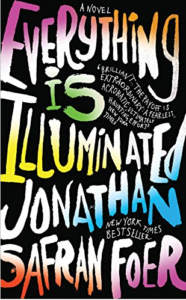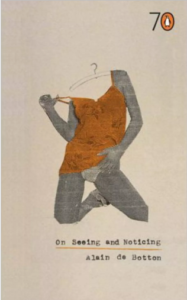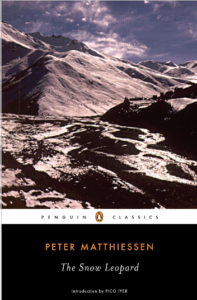6 Amazing Examples of Book Cover Art To Inspire Yours by Kayleigh Alexandra

Please welcome guest author, Kayleigh Alexandra as she shares with us “6 Amazing Examples of Book Cover Art To Inspire Yours.” Enjoy!
***
“Don’t judge a book by its cover” is a phrase we’re all familiar with… and it’s good advice. But sometimes we see a cover that just blows us away, and for good reason. I’ve picked six examples of my favorite book cover art and broken them down to see just what makes them so good — and how you can create a cover for your book that’s just as dazzling.
John Betjeman: Poems Selected By Hugo Williams
I love this cover for so many reasons: the idiosyncratic drawings of English village life, the way the monochromatic style really pops, how the illustration fills up every corner of the cover… But what really makes this cover work is the great use of negative space to draw focus to the title. Even though the illustration is so busy, the reader’s gaze is still drawn to the title, framed in a neutral white space.
Top takeaway tip
Don’t be afraid to use negative space to create focus where you need it. If you’ve got a loud, busy cover, experiment with some considered neutral space to shift focus towards your title and author name. Try to make it seem part of the design (like in the example above) to create a visually seamless style.
Jonathan Safran Foer: Everything Is Illuminated
What can I say about Jonathan Safran Foer’s Everything Is Illuminated? Aside from being a fantastic read, it also boasts a fantastic cover too. A careful, considered use of color gently pervades the lettering, and the somber black background really makes the title stand out. I especially love the way the title fills the cover as though it’s threatening to burst out over the edges.
Top takeaway tip
Your book cover doesn’t necessarily need to have a central image or photo to look good. The above is a fine example of how a creative interpretation of your book’s title can create a cover that transfixes your readers. Experiment with a few designs and pick the elements that you like best for yours.
Alain de Botton: On Seeing And Noticing
For those not in the know, Alain de Botton’s On Seeing And Noticing is a philosophical exploration of how we see ourselves, our emotions, and our self-image in society today. With that in mind, it’s easy to see how the cover reveals exactly what’s in-store for the reader. A woman posed suggestively with a question mark and clothes hanger for a head indicates exactly what de Botton will be exploring in this fascinating book.
Top takeaway tip
Your cover is an opportunity for you to hint to your readers just what they can expect from your book. It doesn’t need to be overt either — sometimes a subtle clue like the example above can be enough to pique your audience’s interests.
Do some mind-mapping around your book’s topic to find a unique angle to approach your cover design from. Don’t hold back, really let your creative juices flow!
Dustin Long: Bad Teeth
As an aspiring writer yourself, I don’t need to explain how popular e-books have become. They’re especially important for hard-working, self-published writers doing their own book marketing to get their work seen. As such, it’s important that your book cover looks good as a thumbnail on digital marketplaces (not a problem Ernest Hemingway ever had to worry about!).
That’s why Dustin Long’s Bad Teeth is so great. Not only is it a clever cover with the books resembling teeth, but it’s also structured perfectly, ensuring it looks clear and visible online.
Top takeaway tip
It’s important that you strike the right balance between aesthetically pleasing and practical when you’re designing your book cover. The colors should complement each other, not clash. And there should be enough spacing between the different components to ensure everything is clearly visible. Read some more tips on the perfect book cover thumbnail here.
Michael Pollan: The End Of Food
When I first saw this cover, it made me stop in my tracks. Not only is the title enough to grab you, but the unusual image of an empty Styrofoam tray covered in Saran wrap really makes you think. Plus, the contrast between the burning orange background and the mint green tray is bold and striking. Bonus points for transforming the title into a food label too.
Top takeaway tip
Try and make your reader really think when they see your cover. An unusual or striking image like the above is perfect because it presents something beyond the everyday. Strive to create an image that takes the viewer out of their reverie and makes them ask questions or evokes an emotional response from them — go for the jugular.
Peter Matthiessen: The Snow Leopard
Evoking grueling expeditions in Himalayan mountains, the photo on this cover gives me chills when I see it. It truly brings to mind the sheer awe and wonder of nature, and the old style of film gives it a nice historic feel. And the fact that the eponymous snow leopard doesn’t feature anywhere on the cover reminds you just how elusive this mysterious creature really is.
Top takeaway tip
Sometimes a simple photo can create a breathtaking book cover that’ll really hook your readers in. Taking your own photos for some 100% original content is great, but frankly not always feasible (especially if you’re in California writing about the remote Himalayan mountains!).
Instead, find some free-to-use photography online that really stands out from the usual tired stock photo offerings. Burst is one option that offers original, high-quality photography that really dazzles. And to really make it unique, try using a free photo editor like piZap to make it yours.
A beautiful cover isn’t the most important aspect of your book — but it’s certainly up there. It’s what will grab your potential readers’ attention when they’re scrolling through digital marketplaces, so it’s worth perfecting. Armed with the takeaways above, you’re now well on your way to creating an exemplary book cover worthy of this list!
***
ABOUT THE AUTHOR

Kayleigh Alexandra is an ardent writer herself, and loves using her passion to help and empower others through Micro Startups, where she shares tips and advice on self-development, startups, and entrepreneurship. For all the latest, follow her on Twitter @getmicrostarted.













I have found that commissioning artist friends to create my cover when I am stuck in the mushy middle of the book is an excellent way to motivate myself to keep on plowing on.
It may cost more than something done via Fiverr or other popular ways to get one made cheaply, but it has far more of an emotional impact to me, and is a nice way of spreading the love around.
I realise this might not work for genres like romance where were you need realism and models and such.
Thanks, David! That’s a great way to keep motivated, and sounds fun too! Emotional impact and spreading the love — I’m all for that.